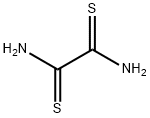| Identification | More | [Name]
Dithiooxamide | [CAS]
79-40-3 | [Synonyms]
DITHIOOXALAMIDE
DITHIOOXALIC DIAMIDE
DITHIOOXAMIDE
ETHANEDITHIOAMIDE
RUBEANE
RUBEAN-HYDROGEN
RUBEANIC ACID
dithiono-oxalicacidiamide
dithio-oxaldiimidicaci
dithio-oxamid
Dithioxamide
Hydrogen rubeanide
Hydrorubeanic acid
hydrorubeanicacid
Oxaldiimidic acid, dithio-
Oxamide, dithio-
oxamide,dithio-
Rubean
RubeznicacidEthanedithioamide
RVK | [EINECS(EC#)]
201-203-9 | [Molecular Formula]
C2H4N2S2 | [MDL Number]
MFCD00004941 | [Molecular Weight]
120.2 | [MOL File]
79-40-3.mol |
| Chemical Properties | Back Directory | [Appearance]
orange to brown crystalline powder | [Melting point ]
≥300 °C(lit.) | [Boiling point ]
287.76°C (estimate) | [bulk density]
650kg/m3 | [density ]
1.353 (estimate) | [refractive index ]
1.5300 (estimate) | [storage temp. ]
Keep in dark place,Sealed in dry,Room Temperature | [solubility ]
ethanol: soluble40mg/10 mL, clear, red | [form ]
solid | [pka]
pK1:10.89 (25°C) | [color ]
Orange to Amber to Dark red | [Stability:]
Stable. | [Water Solubility ]
Soluble in alcohols. Slightly soluble in water. Insoluble in ether | [Merck ]
8279 | [BRN ]
605577 | [InChIKey]
OAEGRYMCJYIXQT-UHFFFAOYSA-N | [CAS DataBase Reference]
79-40-3(CAS DataBase Reference) | [NIST Chemistry Reference]
Ethanedithioamide(79-40-3) | [EPA Substance Registry System]
79-40-3(EPA Substance) |
| Safety Data | Back Directory | [Hazard Codes ]
Xn | [Risk Statements ]
R22:Harmful if swallowed.
R36/37/38:Irritating to eyes, respiratory system and skin . | [Safety Statements ]
S36/37:Wear suitable protective clothing and gloves . | [WGK Germany ]
3
| [RTECS ]
RP1575000
| [TSCA ]
Yes | [HS Code ]
29309070 | [Safety Profile]
Poison by ingestion,
intraperitoneal, and intravenous routes.
When heated to decomposition it emits very
toxic fumes of NOx and SOx | [Hazardous Substances Data]
79-40-3(Hazardous Substances Data) | [Toxicity]
LD50 orally in Rabbit: 500 mg/kg |
| Hazard Information | Back Directory | [Chemical Properties]
orange to brown crystalline powder | [Uses]
As a reagent for copper, cobalt, and nickel. As a stabilizer of ascorbic acid solutions: Smoczkiewicz, Grochmalicka, Nature 192, 16 (1961). | [Uses]
Dithiooxamide acts as a chelating agent and used in the determination of copper(II), nickel(II) and cobalt(II). It is used as a building block in the synthesis of cyclen. It is involved in the preparation of thiazolothiazole-linked porous organic polymers and N,N'-disubstituted dithiooxamides. It is also employed as a modifier to prepare the modified glassy carbon electrode which is used to investigate the electrochemical properties of quercetin, an important flavonoid derivative. Further, it is involved in the preparation of chelating resin with formaldehyde, which finds application in separation and concentration of silver ions. | [Uses]
Rubeanic acid may be used for the quantitative precipitation of copper, nickel
and cobalt. The copper complex is dark green, the cobalt brownish-red and the
nickel violet. All these complexes are chelates of outstanding stability, and this,
together with their vivid Colours, affords the reaction great analytical sensitivity.
The copper complex is the most stable of the three; it can be precipitated even
from mild mineral acidic solution, while precipitation of the corresponding cobalt
and nickel complexes requires buffered media. On the other hand, palladium,
platinum and silver react with rubeanic acid to give precipitates in strongly acidic
solution. It should be mentioned, however, that in the case of platinum and
some other metals (zinc, cadmium, silver, lead, mercury) the product is the corresponding
sulfide rather than the rubeanate complex.
Rubeanic acid reacts with ruthenium to give a blue water-soluble complex ion,
which is utilized for the spectrophotometric determination of ruthenium.
Rubeanic acid has similarly been used for the spectrophotometric determination
of osmium.
It has also proved suitable for the solvent extraction separation and determination
of thallium. It has been found that thallium exists in the organic phase
in the form of a complex of composition Tl/dto/Hdto, where dto represents the
rubeanate anion with one negative charge. | [General Description]
Dithiooxamide is reported to form complexes with Ni(II). | [Purification Methods]
Crystallise dithiooxamide from EtOH and sublime it at high vacuum. [Beilstein 2 IV 1871.] |
|
|





